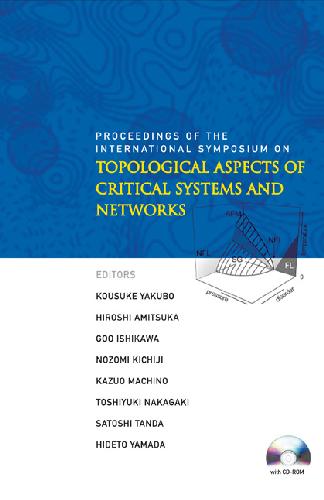Kousuke Yakubo, Hiroshi Amitsuka, Goo Ishikawa, Kazuo Machino, Toshiyuki Nakagaki, Satosti Tanda, Hideto Yamada & Nozomi Kichiji978-981-270-736-0, 981-270-736-9
Table of contents :
CONTENTS……Page 8
Preface……Page 6
International Symposium on Topological Aspects of Critical Systems and Networks……Page 12
Group Photo……Page 14
I. General Properties of Networks……Page 15
1. Introduction……Page 17
2. Model of cascades in complex networks……Page 18
3. Formula for phase-transition point c……Page 19
4. Determination of s: criterion for designing cascade-free networks……Page 21
5. Discussions……Page 22
References……Page 24
1. Introduction……Page 25
2. SIS model……Page 26
3. SIRS-type Models……Page 27
4. Multi-state Epidemic Dynamics……Page 29
References……Page 30
Homotopy Reduction of Complex Networks Y. Hiraoka and T. Ichinomiya……Page 32
References……Page 37
Analysis of the Susceptible-Infected-Susceptible Model on Complex Network T. Ichinomiya……Page 38
References……Page 43
II. Complexity in Social Science……Page 45
1. Introduction……Page 47
2. Model……Page 48
3. Simulations……Page 49
4. Conclusions……Page 51
References……Page 52
1. Introduction……Page 54
2. Long-tailed Distribution of Duration of Disability for Aged People……Page 55
3. Food Fragmentation by Human Mastication……Page 58
4. Conclusion……Page 61
References……Page 62
Two-Class Structure of Income Distribution in the USA: Exponential Bulk and Power-Law Tail V. M. Yakovenko and A. Christian Silva……Page 63
References……Page 71
1. Introduction……Page 73
2. Two Community Currencies……Page 74
3. Zipf ’s Law……Page 76
4. Summary……Page 77
References……Page 78
III. Patterns in Biological Objects……Page 79
1. Introduction……Page 81
2. Mathematical Model……Page 82
3. Stoichiometric Network Analysis and Classification of Oscillatory Dynamics……Page 85
4. Conclusions……Page 93
References……Page 94
1. Collective Cell Movement……Page 96
3. Lumen Formation of Epithelial Cells……Page 98
References……Page 99
Indecisive Behavior of Amoeba Crossing an Environmental Barrier S. Takagi, Y. Nishiura, T. Nakagaki, T. Ueda and K.-I. Ueda……Page 100
2.1. Materials and methods……Page 101
2.2. Experimental result……Page 102
2.3. Experiment on the frontal tip activity of locomotion……Page 103
3. Mathematical Model……Page 104
4. Discussion……Page 106
References……Page 107
Effects of Amount of Food on Path Selection in the Transport Network of an Amoeboid Organism T. Nakagaki, T. Saigusa, A. Tero and R. Kobayashi……Page 108
2. Accumulation of mass of organism to FS in relation to the amount of nutrient at the FS……Page 109
4. Order of tube collapse among five connections of different lengths between two FSs……Page 110
5. Mathematical modeling of tube selection between two FSs……Page 111
6. Possible physiological significance of tube selection involving three FSs……Page 113
References……Page 114
1. Introduction……Page 115
2. Experiment……Page 116
4. Discussion……Page 117
References……Page 119
Blood Flow Velocity in the Choroid in Punctate Inner Choroidopathy and Vogt–Koyanagi–Harada Disease; and Multifractal Analysis of Choroidal Blood Flow in Age-Related Macular Degeneration K. Yoshida, W. Saito, H. Fujii and K. Yakubo……Page 120
2. LASER SPECKLE FLOWGRAPHY……Page 121
4. VOGT-KOYANAGI-HARADA DISEASE……Page 122
5. MULTIFRACTAL ANALYSIS OF CHOROIDAL BLOOD FLOW……Page 123
References……Page 126
Topological Analysis of Placental Arteries: Correlation with Neonatal Growth H. Yamada and K. Yakubo……Page 128
2.1. Patients characteristics……Page 129
2.2. Network indices as topological determinants……Page 130
3. Results……Page 131
4. Discussion……Page 134
References……Page 135
IV. Criticality in Pure and Applied Physics……Page 137
1. Introduction……Page 139
2. The model……Page 140
3. Replica symmetry breaking……Page 142
4. Droplet tunneling……Page 143
References……Page 147
1. Correlated, Heavy, Non-Fermi-Liquid Electron Systems……Page 149
2. Spectroscopic Techniques: NMR and µSR……Page 152
3. NMR/ SR and UCu5-xPdx……Page 153
4. NMR/ SR in Other NFL Systems……Page 154
Acknowledgments……Page 155
References……Page 156
1. Introduction……Page 157
2. Experimental review……Page 159
3. Discussion……Page 161
References……Page 163
Emergent Phases via Fermi Surface Reconstruction near the Metamagnetic Quantum Critical Point in U(Ru1-xRhx)2Si2 K. H. Kim, Y. S. Oh, N. Harrison, P. A. Sharma, M. Jaime, H. Amitsuka and J. A. Mydosh……Page 165
1. Introduction……Page 166
3.1. Construction of phase diagram……Page 167
3.2. Evidences of quantum criticality……Page 169
3.3. Nexus between phase formation and quantum critical point via avoiding quasiparticle instability……Page 170
3.4. Discontinuous Hall coefficient changes……Page 171
References……Page 172
1. Introduction……Page 173
3. Interpretation……Page 174
4. Consequences of the model……Page 177
5. The electronic topological transition……Page 178
References……Page 179
Phase Transition between the Itinerant and the Localized f-electron States in Heavy Fermion Antiferromagnet Ce(Ru0.9Rh0.1)2(Si1-yGey)2 Y. Tabata, C. Kanadani, R. Yamaki, T. Taniguchi and S. Kawarazaki……Page 180
References……Page 184
Relation between Magnetism and Metal-Insulator Transition in Mn-Doped SrRuO3 M. Yokoyama, C. Satoh, K. Fujita, Y. Nishihara, H. Kawanaka and H. Bando……Page 186
References……Page 191
1. Introduction……Page 192
3. Results and Discussions……Page 193
Acknowledgments……Page 196
References……Page 197
1. Introduction……Page 198
3. Results and Discussions……Page 200
References……Page 203
1. Introduction……Page 204
2. Experimental……Page 205
3. Results and discussion……Page 206
References……Page 208
1. Introduction……Page 209
2.2. Experimental procedures……Page 210
3. Results and discussion……Page 211
1. Introduction……Page 216
2. Calculational Procedure……Page 217
3. Photogeneration of Solitons and Polarons……Page 218
References……Page 221
1. Introduction……Page 222
2. Model……Page 223
3. Method……Page 224
4. Results……Page 225
Acknowledgment……Page 226
References……Page 227
1. Introduction……Page 228
2. Symmetry Properties……Page 230
2.1. S matrix……Page 231
2.2. Transfer matrix……Page 232
References……Page 233
1. Introduction……Page 234
2. Distribution of fractal dimensions……Page 235
3. Non-fractal critical clusters……Page 237
References……Page 239
1. Introduction……Page 240
2. Poincare disk model……Page 241
3. Model and methods……Page 242
4. Results……Page 243
References……Page 245
1. Introduction……Page 247
2. Schrodinger’s equation in curved surfaces……Page 248
3. Model and methods……Page 249
4. Results and discussions……Page 250
References……Page 252
1. Introduction……Page 253
2. Systems and Formalism……Page 254
3. Charge and Spin Pumping Currents……Page 255
References……Page 258
Charge Density Wave State in Topological Crystal T. Nogawa and K. Nemoto……Page 259
References……Page 262
1. Introduction : Surface acoustic waves and its imaging……Page 263
2. Experiments……Page 264
3. Conclusion……Page 265
References……Page 266
1. Introduction……Page 267
2. Generation of optical vortex by SLM……Page 268
3. Clean vortex generation by improved SLM pattern……Page 270
References……Page 271
1. Introduction……Page 272
2. Derivation of a black hole solution in a topological universe……Page 273
3.1. Trajectories of a massive particle……Page 274
3.2. Trajectories of a massless particle……Page 276
References……Page 277
Author Index……Page 279







Reviews
There are no reviews yet.